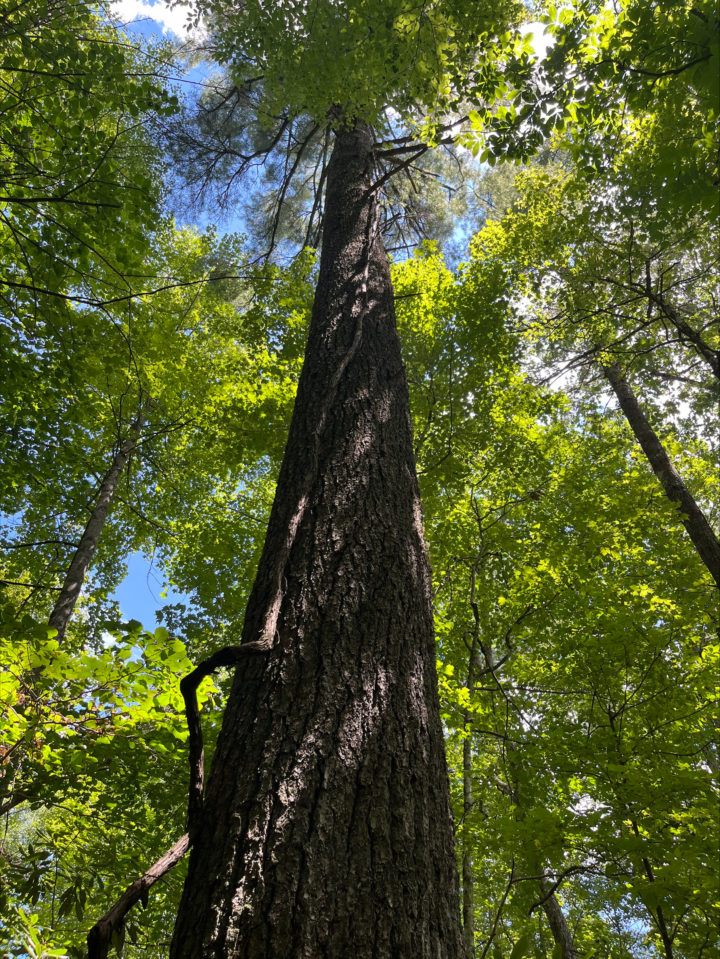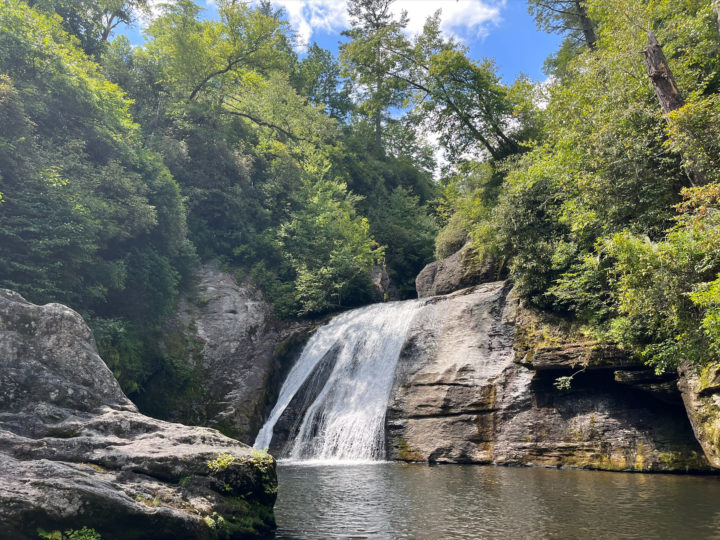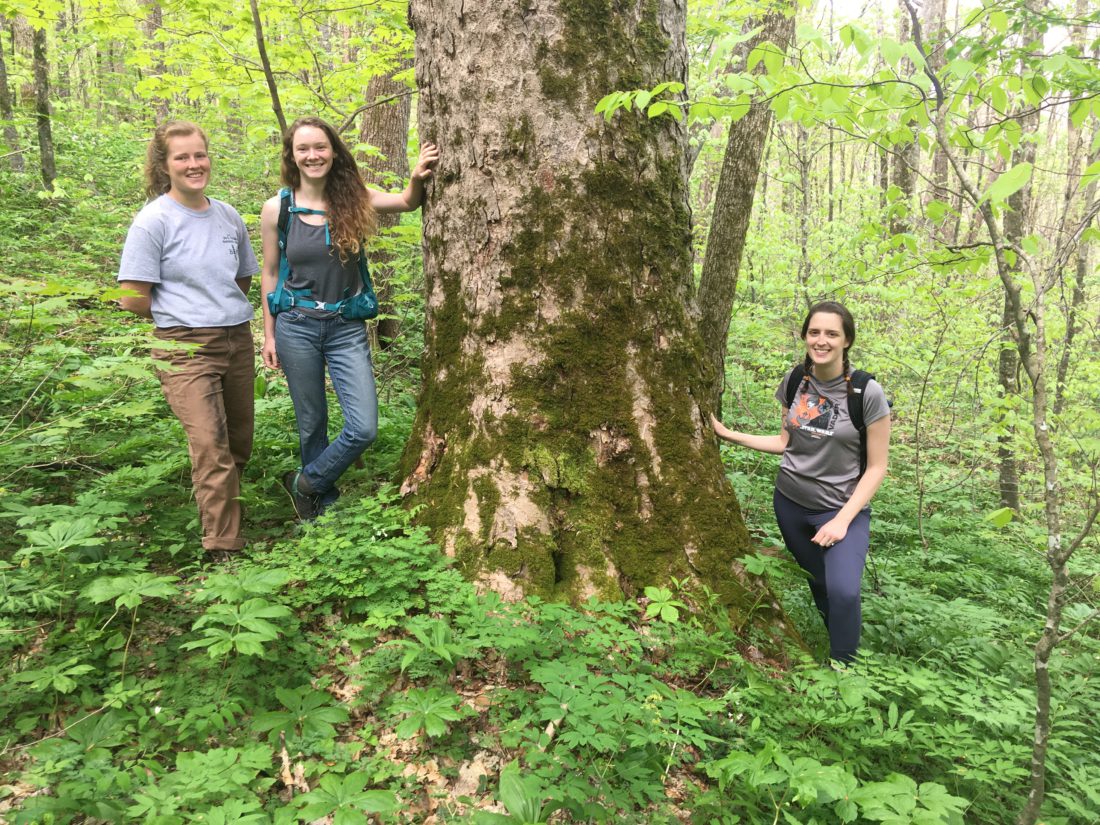Asheville-based nonprofit MountainTrue and others await responses from the U.S. Forest Service after filing a flurry of legal actions against the federal agency over its Pisgah-Nantahala Forest Plan.
The latest lawsuit, submitted April 18, alleges that logging proposals in the forest plan could put endangered bats at risk, therefore violating the Endangered Species Act. (See previous Xpress coverage at avl.mx/dme.)
Two other lawsuits filed since January focus on the Forest Service’s approach to its timber harvest program.
A Feb. 26 lawsuit alleges that the Forest Service’s practice of setting timber targets for forest managers incentivizes them to prioritize harvesting older-growth trees. Furthermore, it maintains that the Forest Service hasn’t assessed the direct, indirect or cumulative effects its actions have on carbon storage and emissions, as required by the National Environmental Policy Act.
The suit stems from internal USFS documents obtained by Southern Environmental Law Center attorneys via the Freedom of Information Act that show how high a priority those timber targets are in decisions across the agency, says Patrick Hunter, the managing attorney in SELC’s Asheville office.
Internal emails show that agency staff members believe the need to meet timber targets impacts the Forest Service’s ability to provide “basic customer service for health and safety,” “keep trails opened and maintained” and “respond to needs resulting from catastrophic events … in a timely manner.” In some instances, agency staff members have used money meant for wildlife habitat improvement to fund projects designed to achieve timber targets, even if those projects had “no benefit to wildlife,” according to SELC’s review of the documents.
“I had no idea how significantly timber targets affect Forest Service decision making across the board, ranging from investment in recreation projects to where to cut timber to how to invest in basic maintenance of Forest Service facilities,” Hunter says. “The agency’s single-minded pursuit of these targets threatens almost every value that people cherish about our national forests, puts the climate at risk and violates federal law.”
That suit joins another, more pointed lawsuit lodged in January accusing the agency of ignoring its own forest plan in moving forward with logging a sensitive area in the Nantahala National Forest. That logging plan is known as the Southside Project.
“With both the Forest Plan and this Southside timber sale, Forest Service leaders have put commercial logging first and ignored federal law and overwhelming public support for conserving our most beloved natural areas and landscapes,” says Josh Kelly, public lands field biologist for MountainTrue in a press release.
At loggerheads
The latest lawsuit, filed jointly by SELC, MountainTrue and four other conservation groups, argues that the USFS ignored its own research when drafting its 2023 Pisgah-Nantahala land management plan, showing that some specific timber projects would drastically harm the habitat and feeding grounds of four endangered bat species.
The 1976 National Forest Management Act requires each forest to have a land management plan to guide the management of forest resources — including conservation, recreation and timber production. Last updated in 1994, the 20-year forest plan covers more than 1 million acres of forest and took 10 years to finalize, partly because of thousands of comments from forest users and advocates.
MountainTrue argued the forest service prioritized “poorly conceived timber harvests” at the expense of water quality and areas critical for the preservation of biodiversity, according to MountainTrue’s objection to the plan while it was being finalized.
Kelly and Karim Olaechea, MountainTrue’s deputy director of strategy and communications, say the Forest Service has acted defensively and vindictively toward Western North Carolina’s largest environmental group since MountainTrue expressed its objections to the plan.
“I think if the forest plan had turned out better, you would not be having this conversation today. I think if the forest plan had turned out better, our relationship with the Forest Service would have been more important than filing the carbon suit, for example. Since filing the notice of intent [to sue] on the forest plan, the reaction from the local leadership of the Forest Service has made it clear that our relationship couldn’t get much worse. So the cost to us is pretty low,” Kelly says.
One example of that, according to Kelly, is the Forest Service has informed MountainTrue that the agency and nonprofit can no longer partner on removing invasive plants from the forest, hurting not only both organizations but the forest itself.
“A lot of this litigation was completely avoidable. And a lot of it is a direct result of a very poorly designed forest plan,” adds Olaechea.
USFS spokesperson for North Carolina forests, Adam Rondeau, did not respond to questions about the agency’s relationship with environmental groups or the lawsuits, citing pending litigation. Instead, he sent general statements about the forest plan and Southside Project.
Timber targets
At the crux of the February lawsuit is the Forest Service’s long-standing practice of using timber targets as mandatory performance metrics for national, regional and forest-level managers, according to the lawsuit.
Since at least World War II, according to Kelly and Hunter, the secretary of agriculture sets annual timber targets that the USFS must meet. Those targets, measured in volume, get divided among the Forest Service’s nine regions, and passed down to individual forests.
The Department of Agriculture and the Forest Service “make no effort to comply” with the National Environmental Policy Act’s requirement that federal agencies analyze and disclose the direct, indirect and cumulative effects of their actions, as well as the effects of a reasonable range of alternatives, according to the lawsuit. In other words, the Forest Service isn’t analyzing and reporting how timber harvests affect carbon emissions in an era when the Biden administration claims to value old-growth forests and prioritize its response to climate change

The Forest Service does review how some individual projects affect carbon storage and sequestration through an environmental impact statement, Hunter acknowledges, but it doesn’t consider the cumulative effect all its harvests are having on carbon storage and emissions as a result of its timber harvest goals. Instead, the reviews it does are conducted on an island, as if no other timber is being harvested in other forests.
The USFS “dismisses the siloed effects of individual logging projects as ‘minuscule’ or ‘imperceptibly small’ drops in the bucket but never considers the effect of the full bucket of projects authorized to achieve timber targets,” the lawsuit alleges.
“This lawsuit is trying to force the Forest Service to look at the overall effect of the numerous projects it authorizes each year to hit these timber targets,” Hunter says.
“If you’re in the Forest Service, and you want to move up in the Forest Service, you want to be able to show your supervisors that you can take a limited amount of funding and hit your timber target,” Hunter continues. “So to do that, there are strong incentives pushing the agency to harvest forest that would produce a lot of volume, which mostly means mature and older and old-growth forest rather than engage in timbering activities that may or may do more ecological good, but not produce as much volume.”
As a result, carbon-dense forests with lower relative risk of wildfire, like in the South and the East, are often logged most heavily. That’s why Kelly calls the timber targets the No. 1 threat to national forests in the eastern and southern U.S., eclipsing wildfires, insects and disease.
WNC projects
Close to home, the prioritization of volume timber harvests could impact a number of areas, particularly in the Nantahala National Forest.
Tod Fullerton, who lives in Clay County, frequents an area of the forest that includes a logging activity known as the Buck Creek Project. He says part of the beauty and value of the area is its remote, wilderness feel that would be significantly disturbed by a timber harvest.
“It would really take away an area that I would have the ability to go visit. One of the beauties of that area, by my definition, is it is hard to get to. Maybe this is where my idealism comes in, in that I think there are landscapes that should be set aside just for the sake of landscapes and what lives there, not us,” he says.
Some of the Buck Creek Project area includes steep sloped forest that, while hard to access, provide value as a buffer, wildlife corridor and carbon sink, and is one of the reasons he chooses to live there, he says.
Ultimately, in Western North Carolina, because of the amount of areas protected from logging, the greatest danger of the USFS’ timber targets are in the types of forest being prioritized for harvest, Kelly says.
“It’s not a matter of the amount of timber that’s being cut. It’s where it’s being cut, especially locally. There’s not too much timber being cut in the Pisgah and Nanatahala national forests; it’s the fact that some of the most sensitive places in old-growth forests are still being targeted when they don’t have to be. That’s so frustrating,” Kelly says.
Southside Project
The lawsuit on the Southside Project, filed Jan. 31, alleges that the USFS is moving forward with a logging project in an ecologically sensitive area that its own latest forest plan defines as a “special interest area” in southern Macon and Jackson counties.
The project, which was approved under a previous forest management plan, aims to cut more than 90% of the trees in a 15-acre area, including areas that are within 100 feet of the Whitewater River, Kelly says. That would violate its own management plan, which gives the area more protections.
The Whitewater River, which contains multiple waterfalls, is a tributary of the Chattooga River, a wild and scenic river known for its pristine fishing and recreational paddling opportunities. Will Harlan, a senior scientist and southwest director of the Center for Biological Diversity, calls the area “one of the most stunningly scenic gorges anywhere in the East.”

“The Whitewater is a world-class recreational river and an ecological treasure. This is a perfect example of how the Forest Service is headed in the wrong direction. They should be protecting places like this and logging elsewhere. Instead, they are targeting some of our most pristine and special places,” Harlan says.
The Center for Biological Diversity signed onto the suit with MountainTrue and SELC, along with the Chattooga Conservancy, Defenders of Wildlife and the Sierra Club.
Kelly says he thinks the project slipped through the cracks while there was turnover in district rangers while the forest plan was coming together. He is “very confident” that the environmental groups will win the lawsuit on the Southside Project.
In a statement about the project, Rondeau, the USFS spokesperson, argues that the 15 acres under litigation is dominated by white pine, and the project’s goals are to remove white pine to allow for oak and hickory regeneration.
“The project land and area nearby has been designated as a Special Interest Area due to its high ecological diversity. However, the portion of the Special Interest Area dominated by white pine is not as healthy or ecologically diverse. Rather than exclude this portion from the Special Interest Area, our specialists recognized that some work on these 15 acres could improve the area’s resiliency and forest health overall,” he says.
Kelly disputes Rondeau’s assertions that the Forest Service simply aims to remove the white pine.
“The Forest Service could have limited itself to removing only white pine in this stand if that’s what it thought was ecologically appropriate. It did not,” he says. “Instead of agreeing to only harvest white pine, the Forest Service decided to authorize more aggressive logging. The stands in the Southside Project area with the highest concentration of white pine and the lowest concentration of oaks are those that have been cut by the Forest Service in the last 20-30 years.”
Kelly claims white pines make up less than half of square footage of trees in the stand, and the Forest Service proposes reducing the square footage of trees from 140 to 20 square feet per acre.
Beyond the makeup of the stand, Kelly says the point of the lawsuit is simply that in its own updated management plan, the USFS acknowledged the particular ecological importance of the area included in the Southside Project, deeming it worthy of protection.
Therefore, he says, they should follow their own advice and avoid logging the area as planned.
What happens next
Kelly, Olaechea and Hunter all made it clear that the groups signing on to the lawsuits are not against responsible logging in the forest.
“We’re strong believers and supporters of a balanced approach to forest management that does include sustainable logging,” Olaechea says.
As part of an attempted compromise with the Forest Service, for example, Kelly notes that 400 MountainTrue supporters advocated for 600 acres of logging instead of 795 in the Buck Creek Project area in order to minimize environmental impacts while still allowing for a significant timber harvest.
There is a way for forest management to include sensible logging while minimizing damage to the forests and maximizing its carbon storage capabilities, Kelly argues. But the crux of both of these lawsuits is the Forest Service is not adequately analyzing the impacts its projects may have.
“It’s the fact that they have never, and they do not analyze the cumulative carbon impacts of these targets. That’s the critical part. And that really does run contrary to the [Biden] administration’s larger goals around climate change and protecting old-growth [forests],” Olaechea says.
The solution, Kelly notes, is quite simple.
“We want the Forest Service to evaluate the impacts to carbon. As soon as they do that, then all the calls for relief are satisfied. So the impact that this ends up having can be remedied pretty quickly,” he says.
That being said, Hunter says that while the SELC would much rather solve these issues outside of court, the group won’t hesitate to continue using legal actions if the Forest Service refuses to work with them.
“I just hope the Forest Service agrees to do the analysis, and that by doing the analysis, they’re able to make more balanced decisions and value other resources to the same extent as producing timber,” Kelly says.




“..the forest service prioritized ‘poorly conceived timber harvests’ at the expense of water quality and areas critical for the preservation of biodiversity, according to MountainTrue’s objection to the plan while it was being finalized.” AND… “the lawsuit alleges that the U.S. Forest Service’s long-standing practice of setting timber targets for forest managers incentivizes them to prioritize harvesting older growth trees.” ABSOLUTELY …and many thanks to all the plaintiffs in these so very important law suits.
People can keep cutting down forests and then patting themselves on the backs for planting saplings, but that only proves that their brains aren’t even as developed as saplings.